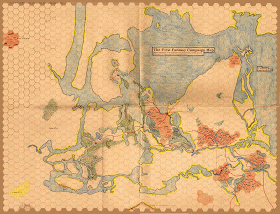Ah, the hex crawl. Those fun and random things that feel like genuine exploration because they're so unscripted that even the GM doesn't know what's gonna happen next. And they can certainly reduce the GM's workload. But they can also be challenging when multiple charts are consulted, and the randomness can sometimes work against any sense of an abiding, living world.
So in the interest of compromise and the best of both worlds, we present our hex-crawling tips...
(1) COLOR CODE REGIONS
That's right. Color code your map to delineate different geographic regions, like green for plains and brown for deserts.
(1) COLOR CODE REGIONS
That's right. Color code your map to delineate different geographic regions, like green for plains and brown for deserts.
You might also consider region-specific restrictions to movement, like 10' per round in bogs or whatever.
Color coding means you can quickly and easily break down regions without looking up names. And you can color code any corresponding tables as well for (much easier) reference during gameplay.
Color coding means you can quickly and easily break down regions without looking up names. And you can color code any corresponding tables as well for (much easier) reference during gameplay.
(2) STOCK "PERMANENT" ENCOUNTERS
This might be a legendary dragon known to reside on a distant mountain peak or a terrible band of robbers with a den deep in the primordial woods, etc. See what we're getting at?
 |
| Dave Arneson's famous Blackmoor map... |
Design the lair and stock it accordingly. These are "little modules" of a sort, but try to keep it to just one or two per region to ease your own workload. It doesn't have to be all at once.
(3) WRITE "CUSTOM" ENCOUNTERS
Color coding helps here. Now you can make region-specific encounter tables that are not only shorter, but still capable of substantial variety consistent with the geography in question.
(4) DO THE SAME FOR SPECIAL MAGIC ITEMS
Potions and scrolls (and other disposables) are fairly common and relatively "mass produced" as it were. But other things, like enchanted weaponry, should be somewhat unique. We suggest a general table that emphasizes only the most common objects and refers the user to region-specific tables for more unusual items.
And when an item is found, CROSS IT OFF THE LIST! You can add new stuff later, of course, just wait awhile...
And when an item is found, CROSS IT OFF THE LIST! You can add new stuff later, of course, just wait awhile...
Note that this allows the GM to play with the probabilities of locating something if they don't like the list that comes with the system they happen to be using. Make this your own!
Once again, color coding regions makes it easier to reference whatever charts the GM comes up with and actually makes them easier to use during play if you color code the tables too!
(5) PLACE MAJOR POPULATION CENTERS
 |
| Altitude (and latitude) makes a big difference and present many challenges... |
Once again, color coding regions makes it easier to reference whatever charts the GM comes up with and actually makes them easier to use during play if you color code the tables too!
(5) PLACE MAJOR POPULATION CENTERS
Cities, towns, etc. This is the VERY HEART of world-building!
(6) BONUS! ADD WEATHER
Weather happens, even in a fantasy world. And various factors, including elevation and latitude, will profoundly impact how these things manifest locally. Crafting region-specific daily weather charts is challenging, but generally worth it.
Now you might not know it, but yours-truly is a semi-retired meteorologist, and we've made a weather chart available for free as part of our P&P Wilderness Worksheets. You'll probably need to tailor the impacts slightly to your system of choice, but the chart otherwise tracks the movement of mid-latitude weather systems and accounts for tropical weather, which isn't subject to the same rules by any stretch. We encourage research in any event!
So that's it. Subdivide your map into meaningful divisions, customize smaller random tables that are easier to manage and more regionally specific while simultaneously inserting permanent and semi-permanent features of the landscape...
(6) BONUS! ADD WEATHER
Weather happens, even in a fantasy world. And various factors, including elevation and latitude, will profoundly impact how these things manifest locally. Crafting region-specific daily weather charts is challenging, but generally worth it.
Now you might not know it, but yours-truly is a semi-retired meteorologist, and we've made a weather chart available for free as part of our P&P Wilderness Worksheets. You'll probably need to tailor the impacts slightly to your system of choice, but the chart otherwise tracks the movement of mid-latitude weather systems and accounts for tropical weather, which isn't subject to the same rules by any stretch. We encourage research in any event!
So that's it. Subdivide your map into meaningful divisions, customize smaller random tables that are easier to manage and more regionally specific while simultaneously inserting permanent and semi-permanent features of the landscape...
Hex crawls deviate from the usual pre-stocked dungeon and enable spontaneous exploration. Even so, a truly thriving world DOES exhibit permanent features and occupants, and these should still be prepared in advance to underscore this point. But with the right balance, you can maintain both randomness AND creative depth!

As an ex meteorologist-in-training, I always appreciate awesome weather rules
ReplyDeleteLet them see the map, or a map. Just don't have all the secrets out in the open. They didn't have to search for Lonely Mountain, Moria, or Mount Doom did they?
ReplyDelete